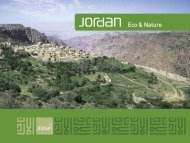You also want an ePaper? Increase the reach of your titles
YUMPU automatically turns print PDFs into web optimized ePapers that Google loves.
THE DEAD SEA & LOT’S CAVE<br />
The Dead Sea is one of the most dramatic places on earth,<br />
with its stunning natural environment equally matched by its<br />
powerful spiritual symbolism. The Bible variously calls it the<br />
“Sea of Arabah”, the “Salt Sea”, or the “Eastern Sea”. Mediaeval<br />
texts refer to it as “the Devil’s Sea”, but the Arab people have<br />
always known it as Bahr Lut (Lot’s Sea).<br />
The infamous Sodom and Gomorrah and other cities of the<br />
Dead Sea plain were the subjects of some of the most dramatic<br />
and enduring Old Testament stories. Soon after Abraham and<br />
his nephew, Lot, arrived in the Dead Sea Plain, they separated<br />
their herds and people and went their own ways (Genesis<br />
13:1-13). God said he would destroy the cities of Sodom and<br />
Gomorrah because of the inhabitant’s wicked and arrogant<br />
ways but Abraham successfully argued with God that Lot<br />
and any other righteous people should be spared. As they<br />
were leaving the burning city of Sodom, Lot’s wife disobeyed<br />
God’s order not to look back and was turned into a pillar of<br />
salt. (Genesis 19:26). Lot and his two daughters survived<br />
and fled to a cave near the small town of Zoar (modern-day<br />
Safi). The Bible says Lot’s daughters gave birth to sons whose<br />
descendents would become the Ammonite and Moabite<br />
people, whose kingdoms were in what is now central Jordan.<br />
The New Testament describes the destruction of Sodom and<br />
Gomorrah as an example in undergoing the punishment of<br />
eternal fire (Jude 1:7). When speaking about human behaviour,<br />
Jesus himself recalled the destruction of Sodom and Gomorrah<br />
and specifically warned “Remember Lot’s wife” and said that “it<br />
would be the same on the day the Son of Man is revealed”, meaning<br />
every person’s fate would depend on whether he or she chose<br />
material possessions or God’s<br />
Kingdom (Luke <strong>17</strong>:28-32).<br />
Although not confirmed, the<br />
sites of the cities of Sodom<br />
and Gomorrah are believed to<br />
be the remains of the ancient<br />
walled towns of Bab ed-Dhra’<br />
and Numeira, in the southeastern<br />
Dead Sea central plain.<br />
They both still show evidence of<br />
destruction by fire, which took<br />
place in the Early Bronze Age,<br />
after which they were never reinhabited.<br />
The three other Cities of the Plain were “Admah,<br />
Zeboiim and Bela, that is Zoah” (Genesis 14:2). The remains of<br />
these places are still buried somewhere around the Dead Sea.<br />
Remains of other Early Bronze Age towns, including massive<br />
burial sites with thousands of graves, have been identified<br />
along the haunting Dead Sea plain, at places such as Feifeh,<br />
Safi, Khneizirah, and others.<br />
The events in the lives of Abraham and Lot probably took<br />
place during the Early or Middle Bronze Age (around 2500-<br />
1500 BC).<br />
By the 6th century AD in the early Christian era more than<br />
2000 years after the Genesis events relating to Sodom and<br />
Gomorrah, Lot and his daughters, the land of Jordan was<br />
dotted with Christian monasteries and churches.<br />
18



